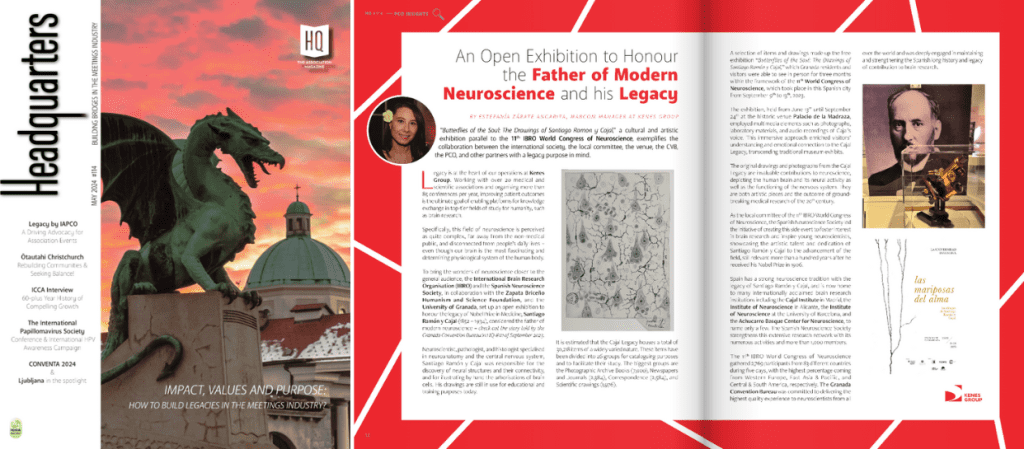
“Butterflies of the Soul: the drawings of Santiago Ramon y Cajal”, a cultural and artistic exhibition parallel to the 11th IBRO World Congress of Neuroscience serves as an exemplifying case of collaboration between the international society, the local committee, the venue, the CVB, the PCO, and other partners, with a legacy purpose in mind.
Legacy is at the heart of our operations at Kenes Group. Working with over 20 medical and scientific associations and organising more than 85 conferences per year, improving patient outcomes is the ultimate goal of enabling platforms for knowledge exchange in top-tier fields of study for humanity, such as brain research.
Specifically, this field of neuroscience is perceived as quite complex, far away from the non-medical public, and disconnected from people’s daily lives – even though our brain is the most fascinating and determining physiological system of the human body.
To bring the wonders of neuroscience closer to the general audience, the International Brain Research Organisation (IBRO) and the Spanish Neuroscience Society (SENC), in collaboration with the Zapata Briceño Humanism and Science Foundation and the University of Granada, set up an open exhibition to honour the legacy of Nobel Prize in Medicine Santiago Ramón y Cajal (1852 – 1934), considered the father of modern neuroscience.
Neuroscientist, pathologist, and histologist specialised in neuroanatomy and the central nervous system, Santiago Ramón y Cajal was responsible for the discovery of neural structures and their connectivity, and for illustrating by hand the arborizations of brain cells. His drawings are still in use for educational and training purposes today.
It is estimated that the Cajal Legacy houses a total of 30,218 items of a widely varied nature. These items have been divided into 26 groups for cataloguing and to facilitate their study. The biggest groups are the Photographic Archive Books (7,000), Newspapers and Journals (2,384), Correspondence (2,584), and Scientific drawings (1,976).
A selection of items and drawings constituted the free exhibition “Butterflies of the Soul: the drawings of Santiago Ramón y Cajal”, which residents and visitors of Granada were able to see in person for three months within the framework of the 11th World Congress of Neuroscience that took place in this Spanish city from September 9th to 13th, 2023.
The exhibition held from June 13th until September 24th at the historic venue, Palacio de la Madraza, employed multimedia elements such as photographs, laboratory materials, and audio recordings of Cajal’s voice. This immersive approach enriched visitors’ understanding and emotional connection to the Cajal Legacy, transcending traditional museum exhibits.
The original drawings and photographs from the Cajal Legacy are invaluable contributions to neuroscience that depict the human brain and its neural activity, as well as the functioning of the nervous system. They are both artistic pieces and the outcome of ground-breaking medical research of the 20th century.
As the local committee of the 11th IBRO World Congress of Neuroscience, the Spanish Neuroscience Society led the initiative of creating this side event to foster interest in brain research and inspire young neuroscientists by showcasing the artistic talent and dedication of Santiago Ramón y Cajal to the advancement of the field, still relevant more than a hundred years after he received his Nobel Prize in 1906.
Spain has a strong neuroscience tradition with the legacy of Santiago Ramón y Cajal, and is now home to many internationally acclaimed brain research institutions including the Cajal Institute in Madrid, the Institute of Neuroscience in Alicante, the Institute of Neuroscience at the University of Barcelona and the Achucarro Basque Center for Neuroscience, to name only a few. The Spanish Neuroscience Society (SENC) strengthens this extensive research network with its numerous activities and more than 1000 members.
The 11th IBRO World Congress of Neuroscience gathered 2,769 participants from 83 different countries during five days, with the highest percentage coming from Western Europe, East Asia & Pacific, and Central & South America, respectively. The Granada Convention Bureau (GCB) was committed to delivering the highest quality experience to neuroscientists from all over the world and was deeply engaged in maintaining and strengthening the Spanish long history and legacy of contribution to brain research.
By
Estefanía Zárate Angarita
Media & Communications Manager
For more information, contact:
Lolita Bizune
IBRO Congress Senior Account Manager
This article was originally published in the #114 issue of the Headquarters Magazine – PCO Insights, page 30, 31 – May 2024: https://bit.ly/4buIqg9
